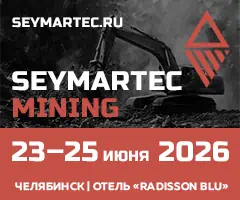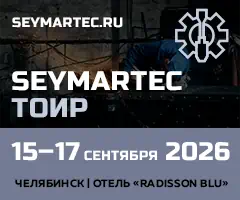Prospective Use of New Sweeper Design to Mine Minerals from Seabed and Ocean Floor
- A.S. Kashirsky1, M.G. Rakhutin2, Yu.V. Kirichenko2, E.A Kuzin3
1 RF Ministry of Industry and Trade, Moscow, The Russian Federation
2 Mining Institute of National University of Science and Technology MISIS, Moscow, The Russian Federation
3 Committee for State Construction Supervision of the City of Moscow, Moscow, The Russian Federation - Russian Mining Industry №6 / 2019 pp.123-127
![]() Abstract: The most promising type of solid minerals to be mined from the seabed and ocean floor are ferro-manganese nodules (FMN) which sizes can vary from a few millimetres to tens of centimetres. The most intensively studied FMN are deposited within the Clarion-Clipperton ore province in the Pacific Ocean and contain such minerals as iron, manganese, nickel, copper and others. Besides natural conditions, the development of deep-sea deposits is hampered by the lack of suitable equipment and efficient technologies for largescale sampling that would help to assess the reserves, nodule abundance and ultimately the commercial viability of mining. A cassette-type sweeper with self-surfacing con-tainers has been developed to eliminate this bottleneck. It is designed for bulk sampling in order to define technological types and grades of ores available at the deposit and to determine technological and economic viability of FMN mining. The paper provides a design description of the cassette-type sweeper and principles of its operation as well as the results of it comparison with existing techniques and means to evaluate subsea deposits.
Abstract: The most promising type of solid minerals to be mined from the seabed and ocean floor are ferro-manganese nodules (FMN) which sizes can vary from a few millimetres to tens of centimetres. The most intensively studied FMN are deposited within the Clarion-Clipperton ore province in the Pacific Ocean and contain such minerals as iron, manganese, nickel, copper and others. Besides natural conditions, the development of deep-sea deposits is hampered by the lack of suitable equipment and efficient technologies for largescale sampling that would help to assess the reserves, nodule abundance and ultimately the commercial viability of mining. A cassette-type sweeper with self-surfacing con-tainers has been developed to eliminate this bottleneck. It is designed for bulk sampling in order to define technological types and grades of ores available at the deposit and to determine technological and economic viability of FMN mining. The paper provides a design description of the cassette-type sweeper and principles of its operation as well as the results of it comparison with existing techniques and means to evaluate subsea deposits.
Keywords: mineral resources, World ocean, ferro-manganese nodules (FMN), geological prospecting operations, geological prospecting equipment and options, sampling, cassette-type sweeper, parameters, design, pass width, load-lifting meshed container
For citation: Kashirsky A.S., Rakhutin M.G., Kirichenko Yu.V., Kuzin E.A Prospective Use of New SweeperDe-sign to Mine Minerals from Seabed and Ocean Floor Gornaya promyshlennost = Russian Mining Industry. 2019;(6):123–127. (In Russ.) DOI 10.30686/1609-9192-2019-6-148-123-127.
This email address is being protected from spambots. You need JavaScript enabled to view it. document.getElementById('cloakbb9969004abcc687d66fb3c12bce69d3').innerHTML = ''; var prefix = 'ma' + 'il' + 'to'; var path = 'hr' + 'ef' + '='; var addybb9969004abcc687d66fb3c12bce69d3 = 'KuzinEA' + '@'; addybb9969004abcc687d66fb3c12bce69d3 = addybb9969004abcc687d66fb3c12bce69d3 + 'mos' + '.' + 'ru'; var addy_textbb9969004abcc687d66fb3c12bce69d3 = 'Article info';document.getElementById('cloakbb9969004abcc687d66fb3c12bce69d3').innerHTML += ''+addy_textbb9969004abcc687d66fb3c12bce69d3+'';
Received: 15.10.2019
Revised: 25.11.2019
Accepted: 05.12.2019
Information about the authors
Alexey S. Kashirskiy – Expert, RF Ministry of Industry and Trade, Moscow, The Russian Federation.
Maxim G. Rakhutin – Doctor of Engineering, Professor, Head of the Department of Mining Machines at the Mining Institute of the MISiS National Research Technological University, Moscow, The Russian Federation, e-mail: This email address is being protected from spambots. You need JavaScript enabled to view it.
Yuriy V. Kirichenko – Doctor of Engineering, Professor, Department of Geology and Mine Surveying at the Mining Institute of the MISiS National Research Technological University, Moscow, The Russian Federation.
Yevgeniy A. Kuzin – Head of Department for Monitoыring and Supervision of Underground Railway Facilities, Committee for State Construction Supervision of the City of Moscow, Moscow, The Russian Federation, e-mail: This email address is being protected from spambots. You need JavaScript enabled to view it.
References
1. Ferro-Manganese Nodules of Pacific Ocean. Under the editorship of Bezrukov P.L. – Proceedings of Institute of Oceanology of the
Academy of Sciences of USSR. Vol. 109. – Moscow: Nedra, 1976. – 301 p.
2. Mineral Resources of World Ocean: Investigation and Development Concepts (for period un-til 2020). / Chief Editor Andreyev S.I.
St.Petersburg, VNII Okeangeologia, 2007. – 97 p.
3. Kozlovskiy E.A., Malyutin Yu.S. World Ocean as Source of Minerals in 21 Century / World Mining Industry 2004-2005. – Vol.1. –
p. 165–179.
4. Galperin A.M., Kirichenko Yu.V, Schekina M.V., Kashirskiy A.S., Yakupov I.I. Assessment of Possibilities to Develop Seafloor Deposits
of Ferro-Manganese Nodules, Part I. Mineral and Raw Material Resources of the World Ocean. – Moscow: Mining Book. – 2014. GIAB –
No.5, – p. 134–142.
5. Galperin A.M., Kirichenko Yu.V, Schekina M.V., Kashirskiy A.S., Yakupov I.I. Assessment of Possibilities to Develop Sea-Floor Deposits
of Ferro-Manganese Nodules, Part II. Development Prospects of Deep-Sea Deposits of Solid Minerals. - Moscow: Mining Book. – 2014.
GIAB – No.6. p. 361-368.
6. Kirichenko U.V., Kashirsky A.S. Development of underwater fields of firm minerals for a solution of the problem of deficiency of
the mineral raw materials. I scientific Reports on Resource Issues 2014, vol.1, innovations in Mineral Resource Value Chains. – 2014,
supported by the IVR Partner Universities, p. 239–247.
7. Zadornov M.M., Romanchuk A.I., Bolotov L.A. Mineral Raw Materials. Ferro-Manganese Formations. / Reference Book. – Moscow:
CJSC «Geoinformmark», 1998. – 46 p.
8. Ferro-Manganese Nodules of Central Pacific. Under the editorship of Murdman I.O., Skornyakova N.S. – Proceedings of Institute of
Oceanology of the Academy of Sciences of USSR. P. 122. – Moscow: Nauka, 1986. – 344 p.
9. Kirichenko Yu.V., Schekina M.V. Earth Science, Part 2. – Moscow: Mining Book. 2009. – 227 p.
10. Method to Mine Ferro-Manganese Nodules from Silty Bottom Sediments and Equipment for its Implementation. RF Patent of Invention
No. 2562304 dated 11.08.2015 / Kirichenko Yu. V., Kashirskiy A.S., Ivaschenko G.S., Yakupov I. I.




